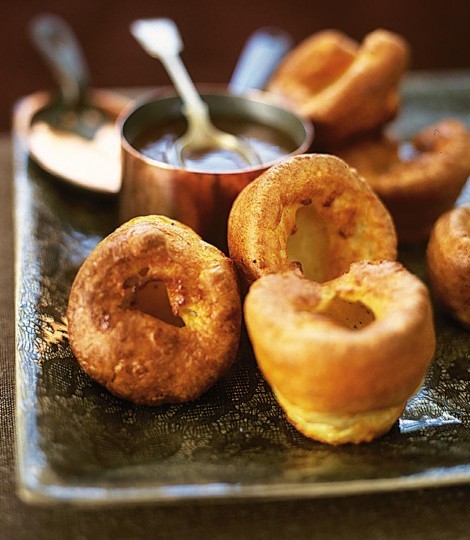The science of Yorkshire puddings
December 30, 2015 by Darcie
There is something both magical and extremely satisfying about making Yorkshire puddings and their popover cousins. The dramatic rise belies the simplicity of the batter. Many – sometimes contradictory – rules surround these popular pastries, with dire consequences predicted if you don’t follow them to the letter. Some authors say that you must rest the batter before baking. Others say the batter must be chilled for proper puffery. J. Kenji López-Alt of Serious Eats tests these theories and more in a treatise on the science of Yorkshire puddings. Kenji states that he picks up where Felicity Cloake leaves off in her excellent article in The Guardian on Yorkshire puddings, in which she tested a half dozen different recipes before landing on her own version.
The first theory Kenji tested was whether a chilled or room temperature batter would produce a higher rise. He says that while the difference is not drastic, warmer batter does rise higher. However, he notes that “there is another thing to consider: Colder batter stayed pooled in the center as the edges rose from the heat of the pan, weighing down the center and creating a more distinct cup shape to the finished puddings.” If you like the cup shape (for instance as a well in which to put a gravy if serving the puddings as a first course), now you know how to achieve it.
So what about the adage that you should rest your batter before making the puddings? A few authors (Delia Smith, Jamie Oliver) say don’t bother, but others such as Marco Pierre White insist upon it. Kenji’s test offered strong evidence to support those who prefer a good rest before baking, He tested six different resting periods, “the first a full six hours before the last, then baked them all side by side in the same oven. Amazingly, there was a direct correlation between how long the batter had rested and how tall the puddings rose.” He stresses the point by saying that “Resting your batter is the single most important step you can take to improving Yorkshire pudding and popovers. Not only do they come out taller, they also come out much tastier, with a more complex, toasty flavor.”
Other theories tested whether the pan must be preheated, how many egg yolks should be used, whether you should use water or just milk, if beef drippings make the best puddings, and if you are doomed by opening the oven before the puddings are done. You can read the results of all of these tests at indexed blog Serious Eats.
Photo of Mustard Yorkshire puddings from Delicious Magazine (UK)
Categories
- All Posts (6940)
- Antipasto (2135)
- Author Articles (247)
- Book News (935)
- Cookbook Giveaways (983)
- Cookbook Lovers (257)
- Cooking Tips (109)
- Culinary News (299)
- Food Biz People (552)
- Food Online (791)
- Holidays & Celebrations (272)
- New Cookbooks (149)
- Recipes (1500)
- Shelf Life With Susie (231)
- What's New on EYB (133)
Archives
Latest Comments
- Atroyer7 on Danube Cookbook Review and Giveaway
- demomcook on What foods do you look forward to the most for each season?
- demomcook on Danube Cookbook Review and Giveaway
- Darcie on How cookbooks can help build resilience
- mholson3 on Danube Cookbook Review and Giveaway
- Rinshin on How cookbooks can help build resilience
- sarahawker on Danube Cookbook Review and Giveaway
- Sand9 on Danube Cookbook Review and Giveaway
- hankintoby29 on Heritage Cookies of the Mediterranean World – Cookbook Giveaway
- WBB613 on Feasts of Good Fortune Cookbook Giveaway